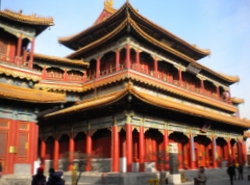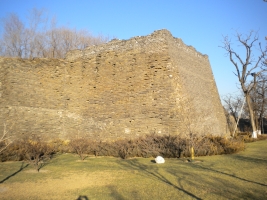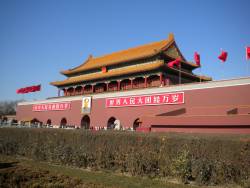Archive for the ‘China Travel’ Category
Tuesday, January 11th, 2011
After exploring the fascinating treasures of the Henan Museum and enjoying the hospitality of Zhengzhou’s very friendly people I returned to Beijing by train on 9 January. Since then I have visited two more of Beijing’s significant attractions – Yonghegong Lama Temple and the Temple of Heaven.
 Yonghegong Lama Temple, the largest lamasery in Beijing, was built in 1694 as the residence of Prince Yong of the Qing Dynasty. After the prince came to the throne as Emperor Yongzheng he in 1725 changed his old residence into a temporary dwelling palace called “Yonghegong” meaning palace of harmony and peace. In 1744 his successor Emperor Qianlong changed the palace into a lama temple. In the temple halls there are many Buddhist statues, paintings and relics including a breathtaking 18-metre high Buddha carved from one piece of white sandalwood. Yonghegong Lama Temple, the largest lamasery in Beijing, was built in 1694 as the residence of Prince Yong of the Qing Dynasty. After the prince came to the throne as Emperor Yongzheng he in 1725 changed his old residence into a temporary dwelling palace called “Yonghegong” meaning palace of harmony and peace. In 1744 his successor Emperor Qianlong changed the palace into a lama temple. In the temple halls there are many Buddhist statues, paintings and relics including a breathtaking 18-metre high Buddha carved from one piece of white sandalwood.
The Temple of Heaven, built from 1420, was where emperors of the Ming and Qing Dynasties went to worship heaven and offer sacrifices to pray for bumper harvests and favourable rain. A spectacular group of ancient temple buildings sits in 273 hectares of beautiful parkland, including the landmark Hall of Prayer for Good Harvests and Circular Mound Altar.
For this part of the trip I’m staying in Dongzhimen, which is located near to the Beijing Worker’s Stadium and Gymnasium and Beijing’s embassy district. Like Chongwenmen where we stayed earlier in the trip, Dongzhimen was previously the location of an ancient city gate. It also has a subway station that accesses two subway lines as well as the Airport Express train service.
Tags: Beijing, Buddha, Buddhism, Buddhist, Circular Mound Altar, Emperor Qianlong, Emperor Yongzheng, Hall of Prayer for Good Harvests, Henan Museum, Ming Dynasty, Prince Yong, Qing Dynasty, Temple of Heaven, Yonghegong, Yonghegong Lama Temple, Zhengzhou Posted in China Travel, My China Trips | Comments Off on Yonghegong Lama Temple and the Temple of Heaven
Wednesday, January 5th, 2011
On 4 January we travelled by train from Beijing to Zhengzhou, capital of Henan province. The train journey took just over 5 hours to travel a distance of about 800 km, and while not high speed rail it was still a fast and efficient service in a very comfortable near-new train.
 The high speed rail line between Beijing and Zhengzhou is currently under construction and when completed the travel time between the two cities will be reduced significantly. The high speed rail line between Beijing and Zhengzhou is currently under construction and when completed the travel time between the two cities will be reduced significantly.
That evening we enjoyed the night view of Zhengzhou from the city’s only revolving restaurant which is on the top floor of the Guang Dong Hotel where we are staying. The view includes nearby Erqi Square and Erqi Tower, a major landmark in central Zhengzhou, as well as the remains of the ancient city wall.
While in Zhengzhou I plan to visit the nationally significant Henan Museum. One of the oldest museums in China, the Henan Museum moved into its present distinctive building in 1998. At present the museum has a collection of more than 130,000 cultural relics, of which more than 5,000 pieces are highly significant treasures.
Tuesday, January 4th, 2011
 On 2 January we took a day trip to the city of Tianjin, famous for its great food and European colonial architecture. The 130km journey from Beijing to Tianjin took only 30 minutes on the new high speed rail service which reached a speed of 325 km/h. China has 17,000 km of high speed rail lines under construction across the country, and metro rail networks are being built in many cities. On 2 January we took a day trip to the city of Tianjin, famous for its great food and European colonial architecture. The 130km journey from Beijing to Tianjin took only 30 minutes on the new high speed rail service which reached a speed of 325 km/h. China has 17,000 km of high speed rail lines under construction across the country, and metro rail networks are being built in many cities.
Beijing’s beautiful Beihai Park was our destination on 3 January. Located in the centre of Beijing, Beihai Park is one of the oldest, largest and best preserved ancient imperial gardens in China with a history of about 1,000 years.
A major landmark in Beihai Park is the majestic White Dagoba which is situated on the peak of Qionghua Islet.
Sunday, January 2nd, 2011
 In Beijing we are staying at Chongwenmen, which means “Chongwen gate”. In Beijing we are staying at Chongwenmen, which means “Chongwen gate”.
Chongwen gate was one of the gates in Beijing’s ancient city wall, and construction of the gate commenced in 1436 in the Ming Dynasty. Chongwen gate no longer stands, however leading east from Chongwenmen a 1.5 km section of the ancient city wall has been protected in the Ming City Wall Site Park.
About 1.5 km west of Chongwenmen another of the gates, Zhenyangmen (Zhenyang gate) still stands at the southern end of Tian’anmen Square. Zhenyangmen is commonly known as Qianmen (front door) and is the highest and most magnificent city gate in Beijing.
Chongwenmen now features major department stores and numerous restaurants as well as a subway station accessing two lines of Beijing’s extensive, efficient and expanding subway network.
Saturday, January 1st, 2011
 Tian’anmen Square and the Imperial Palace (also known as the Forbidden City) were the first of Beijing’s numerous significant attractions that I visited after arriving in China’s capital on 27 December. Tian’anmen Square and the Imperial Palace (also known as the Forbidden City) were the first of Beijing’s numerous significant attractions that I visited after arriving in China’s capital on 27 December.
Tian’anmen Square takes its name from the Tian’anmen gate (Gate of Heavenly Peace) to the Imperial Palace at the north of the square. Under clear blue skies I joined the many people who were in the square visiting the Monument to the People’s Heroes and the Mausoleum of Mao Zedong, and then commenced an exploration of the Imperial Palace. I had seen photographs of the Imperial Palace (Forbidden City), but pictures can’t convey the extraordinary scale and grandeur of this vast complex.
We have since visited Beijing’s ancient Drum and Bell Towers and Prince Gong Mansion, toured historic Hutongs, and of course enjoyed Beijing’s outstanding food.
Tags: Beijing, Bell Tower, Drum Tower, Forbidden City, Hutong, Hutongs, Imperial Palace, Prince Gong Mansion, Tian'anmen, Tian'anmen Square Posted in China Travel, My China Trips | Comments Off on Exploring Beijing’s treasures
|
|
 Yonghegong Lama Temple, the largest lamasery in Beijing, was built in 1694 as the residence of Prince Yong of the Qing Dynasty. After the prince came to the throne as Emperor Yongzheng he in 1725 changed his old residence into a temporary dwelling palace called “Yonghegong” meaning palace of harmony and peace. In 1744 his successor Emperor Qianlong changed the palace into a lama temple. In the temple halls there are many Buddhist statues, paintings and relics including a breathtaking 18-metre high Buddha carved from one piece of white sandalwood.
Yonghegong Lama Temple, the largest lamasery in Beijing, was built in 1694 as the residence of Prince Yong of the Qing Dynasty. After the prince came to the throne as Emperor Yongzheng he in 1725 changed his old residence into a temporary dwelling palace called “Yonghegong” meaning palace of harmony and peace. In 1744 his successor Emperor Qianlong changed the palace into a lama temple. In the temple halls there are many Buddhist statues, paintings and relics including a breathtaking 18-metre high Buddha carved from one piece of white sandalwood. The high speed rail line between Beijing and Zhengzhou is currently under construction and when completed the travel time between the two cities will be reduced significantly.
The high speed rail line between Beijing and Zhengzhou is currently under construction and when completed the travel time between the two cities will be reduced significantly. On 2 January we took a day trip to the city of Tianjin, famous for its great food and European colonial architecture. The 130km journey from Beijing to Tianjin took only 30 minutes on the new high speed rail service which reached a speed of 325 km/h. China has 17,000 km of high speed rail lines under construction across the country, and metro rail networks are being built in many cities.
On 2 January we took a day trip to the city of Tianjin, famous for its great food and European colonial architecture. The 130km journey from Beijing to Tianjin took only 30 minutes on the new high speed rail service which reached a speed of 325 km/h. China has 17,000 km of high speed rail lines under construction across the country, and metro rail networks are being built in many cities. In Beijing we are staying at Chongwenmen, which means “Chongwen gate”.
In Beijing we are staying at Chongwenmen, which means “Chongwen gate”. Tian’anmen Square and the Imperial Palace (also known as the Forbidden City) were the first of Beijing’s numerous significant attractions that I visited after arriving in China’s capital on 27 December.
Tian’anmen Square and the Imperial Palace (also known as the Forbidden City) were the first of Beijing’s numerous significant attractions that I visited after arriving in China’s capital on 27 December.